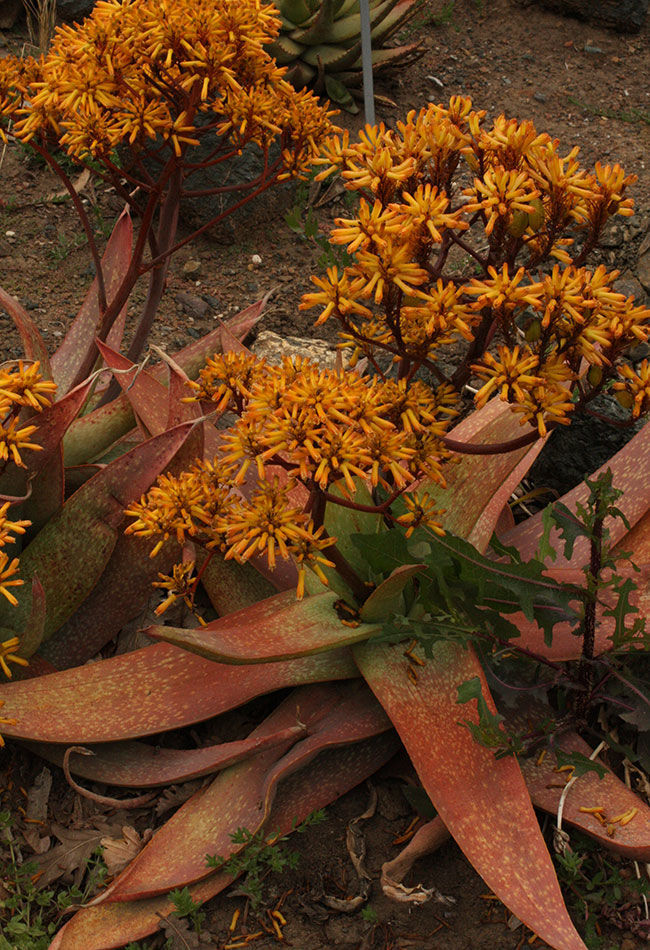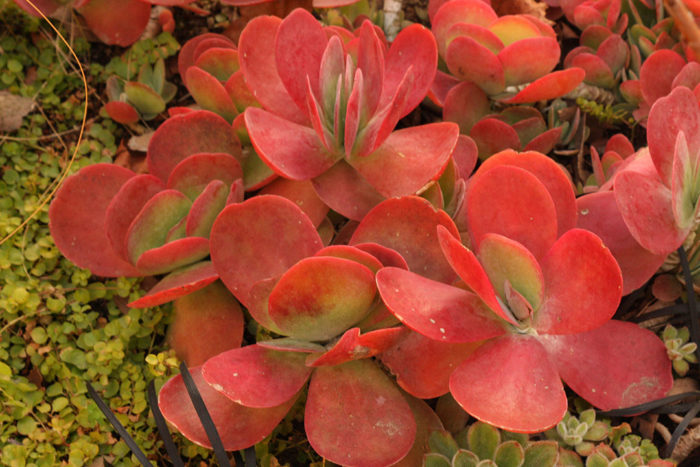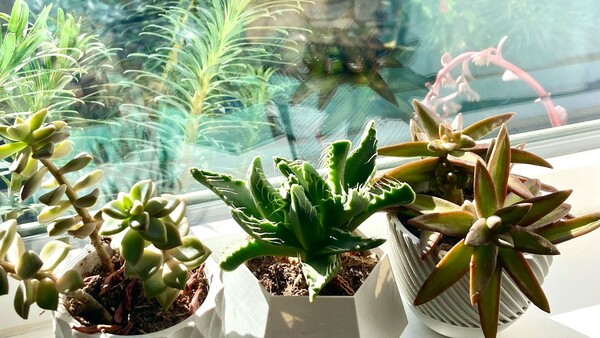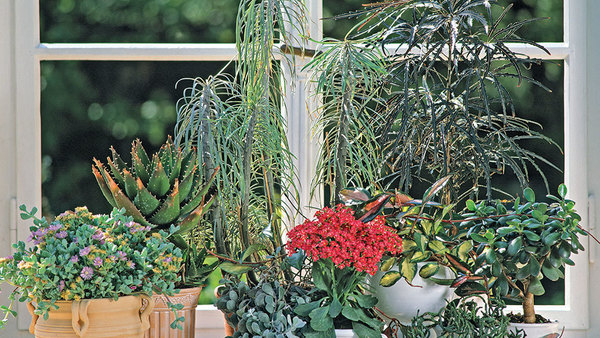
As temperatures soar, all the grass in the neighborhood begins to brown, and you have to deadhead your flowers a day after they bloom, it feels like you’d do almost anything for a spot of color in the garden. One of the best ways of getting color in the hot season from July to September is to grow succulents. You can find succulents that range in color from red, orange, yellow, black, blue, silver, and purple in nurseries throughout Southern California.
Unfortunately, many gardeners are at a loss when they pick up a beautiful red aloe plant (Aloe cameronii, Zones 9–12) at the nursery and, after growing it for a month or two, watch it lose its luscious pop of color and revert to a more muted green or silver. Here’s a quick introduction on growing succulents to maximize their colorful beauty in the dry season.
Plant your succulents in well-draining soil. That may mean adding sand or pumice to your soil or picking up a cactus and succulent potting soil for your container gardens. Most succulents with diseases are suffering from overwatering and heavy, poorly drained soils. This can sometimes turn your succulents an unappealing shade of yellow, often with brown tips or rotting leaves at the base; this is definitely not the color you are aiming for!

Plant your succulents in six or more hours of sun. If your succulents are in the shade, they will revert to a green color eventually. The pigment that creates reds, browns, and oranges in succulents such as aloes (Aloe spp. and cvs., Zones 9–11), sedums (Sedum spp. and cvs., Zones 3–11), and euphorbias (Euphorbia spp. and cvs., Zones 4–11) is an anthocyanin or a carotenoid. These pigments act as a sort of sunscreen for the rest of the plant, which is why you see them in the tips that have more sun exposure. In bluish and silver succulents such as senecio (Senecio spp. and cvs., Zones 9–11), live-forevers (Dudleya spp. and cvs., Zones 8–11), and some echevaria (Echevaria spp. and cvs., Zones 9–11), you may see a whiter, more silver color when exposed to the sun. These plants have adapted to become more reflective of light to reduce sun damage, and they do this by producing wax or hairs on their leaves.
The best way to encourage color in your succulents is to reduce watering. If your succulents are looking mostly green in August, you are probably overwatering them. Reducing watering will bring out warm color tones in your succulents, such as reds, oranges, and pinks. In general, succulents produce color when they are under light, temperature, or water stress. I generally stick to watering my succulents deeply every two weeks in the dry season, and not at all in the rainy season unless there is a drought year.
It is important to remember that you can take the stress too far eventually and cause damage to your garden. If your succulent is retaining its normal form, and it has color, it is healthy. If the plant is misshapen or begins to lose more than 20% of its leaves, there is cause for concern, and you may want to adjust your watering schedule.
Another stressor that can create color in succulents is disease or insect infestation, so keep an eye out for pests if you see color distributed in spots or toward the interior of the plant rather than the tips. Mealybugs and scale insects are common pests in succulents and can be handled organically with direct application of a gentle insecticidal soap mixture.

Although cold temperatures also bring color to succulents, if you live in a frost zone closer to the interior of Southern California, you may need to bring in your succulents in the winter. Some of the nicest varieties, such as velvet leaf kalanchoe (Kalanchoe beharensis, Zones 10–11), a fuzzy silver- and bronze-colored succulent from Madagascar, will turn into slime with frost damage. Since many succulents are easily propagated, you could just bring in cuttings in the cold weather in pots rather than digging up the whole plant. Then, when the threat of frost has passed, you can replant the cuttings in the garden.
One of the best things about a succulent garden is its ability to feel lush and colorful in the dry months, with no wilting or brown leaves or flowers to deadhead in the hot weather. Succulents tend to be low maintenance in our climate, so you can sit and enjoy your garden full of color in September and relax in the cool evenings without worrying about garden chores that need to be done during those days above 90°F.
Rachel Young is the former Director of Horticulture and Garden Operations at Descanso Gardens in La Cañada, California.


















Comments
Log in or create an account to post a comment.
Sign up Log in